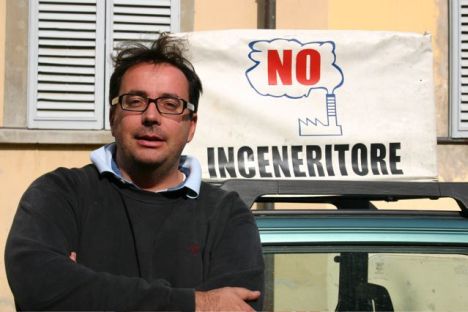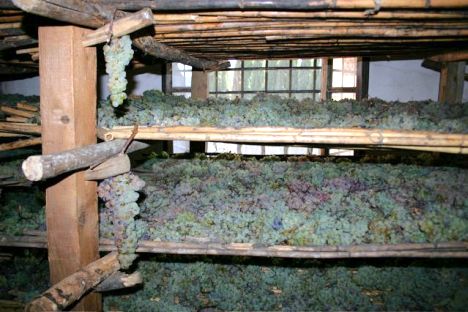Montalcino and
Chianti Classico have been fortunate to have been the focus of wine media attention for the past 20 years. The more the buying public became involved with their wines, the more prices were
able to rise. Prosperity moved into the country, which was not only expressed where rich new vintners refined run-down farms into villas and dusty front yards into ornamental lawns, but also among the simple vintners, where no other income than that from agriculture is available for investments. Certain wine regions of Tuscany have visibly blossomed in the past few years, others, less respected ones like Rùfina, have progressed only slowly in the same time.
Only two names were
able to hold their ground outside Tuscany: Nipozzano and Selvapiana. While the reputation of Selvapiana's
Chianti Rùfina has been lost in a small community of enthusiasts due to the small number of bottles, the Nipozzano
brand is mainly linked to the producer Frescobaldi. Far from Florence, Nipozzano is hardly associated with the origin Rùfina. Everyone knows
Frescobaldi, many know Nipozzano, but few know that Nipozzano is a winery in the Rùfina.
Lamberto Frescobaldi: "In fact, a foreign magazine recently wrote words of praise about Nipozzano, but unfortunately the author put the
estate in the
Chianti Classico area." Alfredo Massetti (Grignano): "Rùfina was asleep when Tuscany was booming. Until the 1980s, the sharecropping could survive here, there was no outside investment, with a few exceptions like Grignano and one or two others." Anyone who bought an
estate here 35 years ago needed some imagination to guess at the creditworthiness of such an investment. For the Inghirami family, the math worked out: Grignano's value has increased about a hundredfold.
However, it is a meager consolation for a farmer that his farm is gaining in value, while his products do not fetch adequate prices. Nico Sartori is from the Veneto region and bought the Altomena olive and wine
estate together with family members 15 years ago. The costs of wine and oil production, as well as the constant investments needed, still exceed the income at Altomena. Nico is the farm manager and has to answer to his family for the farm bill. Resignedly, he notes, "Unfortunately, the only serious justification for investing in such an
estate is the hope that at least the market value of the property will increase."
Wine prices are too low, especially for small numbers of bottles, to bring in more than bare operating costs for the wineries. The export price of a
Chianti averages about half that of a
Chianti Classico, and things don't look much better for
Chianti Rùfina: It may come as a surprise, but
Chianti Rùfina only marginally outperforms
Chianti in terms of image and selling prices.
Sabrina Tanini (Dreolino): "People are interested in
Chianti Rùfina, for example at
Vinitaly, but when they hear that it's more expensive than plain
Chianti, the order quantity immediately shrinks considerably."

|
|
Sabrina Tanini runs the Dreolino winery together with her father and brother
|
Federico Giuntini (
Selvapiana): "The Rùfina is the poor brother of the
Chianti Classico. We have the same production costs, but in terms of bottle prices we are at least a quarter below
Chianti Classico. Only Montesodi by
Frescobaldi or our Bucerchiale come to higher prices."
Graziano Scopetani (Scopetani): "The grape price for Rùfina is about ten percent higher than for normal
Chianti, and ten percent more expensive is the bottle of
Chianti Rùfina, but the customer doesn't like to pay this small price difference." If the
cask wine price of
Chianti Classico was EUR 3.15 per
liter in October 2007, the other
Chianti were already available for EUR 1.35 per liter. (Source: ISMEA.)
Cesare
Coda Annunziante (Colognole): "Tourism is an important communication vehicle: However, the travel and wine press writes only of the
Classico, the Tuscan coast and Siena. The Rùfina is hushed up."
People look towards Siena, not entirely without envy, and look for ways to bring more attention and better prices to
Chianti Rùfina. Federico Giuntini (
Selvapiana): "We are only a few bottling producers and we should be
able to enforce a minimum price for the
Chianti Rùfina. The consortium wants to achieve that a minimum price is set for
Chianti Rùfina sold in barrel to bottlers."

|
|
Graziano Scopetani markets over 80 percent of his annual production of 1%5 million bottles abroad
|
Graziano Scopetani (Scopetani) sees it somewhat differently: "100 years ago, Rùfina wine, not
Chianti Classico, was shipped to America. If today
Chianti Classico is more successful than we are, it's our fault. But I also see the positive: the
Classico is a beautiful area, it's just that it's not Tuscan anymore. Neither are the owners. The Rùfina, on the other hand, still belongs to the old families."
Sure, Rùfina's lag has its advantages. The so-called quality revolution in "Chiantishire" has thrown a
lot over the top. Not only are the owners no longer Tuscan, but worse, the wines are not. It could be a chance for Rùfina winemakers to learn from the mistakes of their
Classico peers and not make Rùfina wines unrecognizable for vanity and commercial reasons. Whether they will, however, is more than questionable
Enrico Lippi (Frascole): "The Rùfina is characterized by the presence of the Frescobaldi. This is certainly an advantage, but also a disadvantage. I notice that actually none of us invests in the Rùfina name, we rather all put our own names in the foreground. There is unbridled individuality, a search for typicality is absent. Yet we really would have a unifying commonality with our particular mesoclimate."
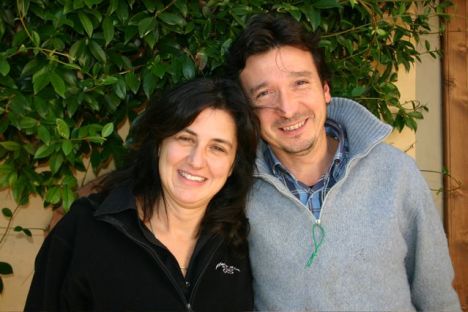
|
|
Elisa & Enrico Lippi produce about 50,000 bottles per year
|
Why Chianti and not simply "Rùfina"?
The wine of Rùfina is called Chianti. It has officially done so since the 1930s, when half of Tuscany named its red wines after the small
wooded area to the north of Siena. But apart from the grape varieties - mainly
Sangiovese - the wines never had much in common. The Rùfina's misfortune was that 150 years ago there was no man of the stature of a
Biondi Santi living here who was headstrong and far-sighted enough to give the special wine a special name. The name
Chianti makes the Rùfina recognizable to the general public as a Tuscan wine. However, the additional name "Chianti" slows down the development towards an independent image of the "Rùfina"
It is the conflict between commercial necessity and long-term marketing. Abandoning the "Chianti" would be like jumping into cold water, which above all the bottlers have no desire to do. Successful producers like Frascole or
Selvapiana, on the other hand, would be ready to take this step immediately. The supporters of the current situation say that the changeover and the promotion would be expensive. They are also worried about the amounts of wine produced in
Chianti Rùfina vineyards but not bottled as such but declassified to Chianti. What would happen to these surplus wines if Rùfina separated from
Chianti? If a price collapse and a decline in the quality of (
Chianti) Rùfina are to be prevented, it must be possible to declassify wine that is not for sale or of lesser quality.
If the next lower level available for this is the simple
Chianti, with the departure of Rùfina from the extended
Chianti family, unneeded wine would have to be put on the market as Toscano IGT. This would entail a painful loss of value. (October 2007:
Chianti: EUR 1.35/liter, Toscano
IGT Sangiovese: EUR 0.60/liter.). The
president of the consortium, Conte Giovanni Busi (Travignoli), is not fundamentally against the
flight forward, but he believes the situation is not yet ripe for the "Rùfina DOCG": "We are a small
appellation and have very limited means to make ourselves known. Nobody knows Rùfina, the little word
Chianti, on the other hand, gives the consumer a clue about the origin." As long as the prices of
Chianti Rùfina are low and not all the possible volume can be sold under this name, the number of opponents of "Rùfina DOCG" will be greater than those in favour.
The
president of the consortium considers the
most urgent task to make the
appellation known. I wanted to know from him how this is to be done. Busi: "Our communication has to consist in bringing wine lovers to us, in the middle of our vineyards, only then they will be
able to understand the particularities of our appellation. Outside our area, we are just a number like all the others."
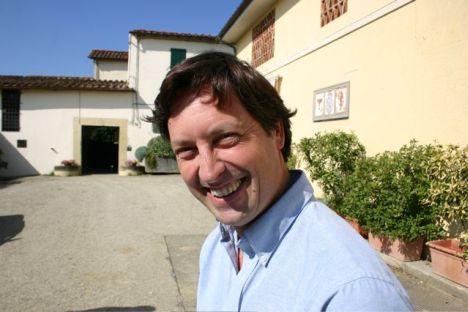
|
|
Giovanni Busi is the president of the Rùfina Consortium
|
And what does he want written about his territory? "It pleases me when I read that we have invested, that we are entrepreneurs, that we believe in our territory and our wine. It annoys me, on the other hand, when the wine press awards wines from our ranks that are atypical of Rùfina." The noble presidente will have to be annoyed many times because a typical
Chianti Rùfina, with its rough edges, does not exactly correspond to the ideal wine of influential opinion makers.
Valentina Libri (
Cerreto Libri) thinks that the image of Rùfina must
first be freed from old baggage, made lighter, that Rùfina still suffers from the inertia of the past. Enrico Lippi (Frascole) is more specific: "What is the point of putting our modest resources into communication if our appearance on the market is contradictory? We must strive for a solid appearance of price, quality and typicality. What is the use of writing nice things about our territory and our wines if the
Chianti Rùfina of company X is offered for Euro 3,70 in the supermarket?
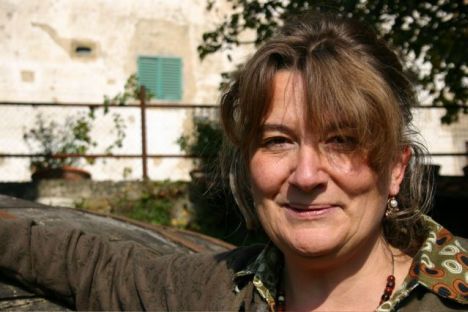
|
|
Valentina Baldini-Libri runs her estate together with her husband in a biodynamic way
|
It is certainly nice for Colognole,
Selvapiana, Frascole and so on if some wine lovers know us and appreciate our wines, but it is unsatisfactory if we are
seen as detached businesses and not as elements of an appellation. I want to be proud to belong to the Rùfina
appellation!"
Click here for the first partClick here for the third partThe above article was kindly made available to us by the Merum editorial team. Many thanks for this. If you would like to order a subscription to Merum, you can do so here:
Order Merum subscriptionAll photos © Merum
